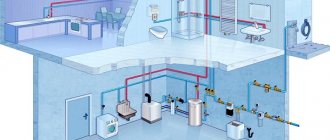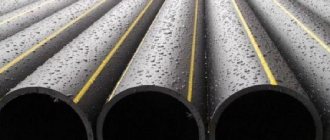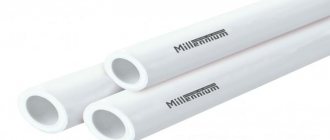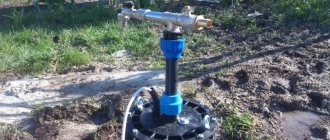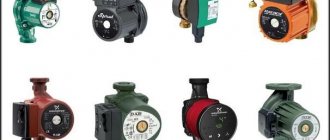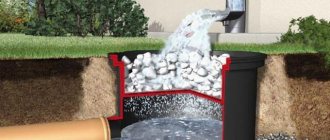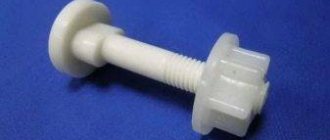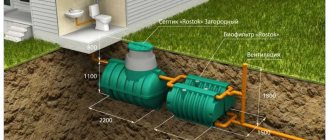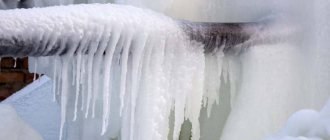Do you want to protect your water supply from freezing in cold weather by installing a heating cable inside the pipe? Agree that preventing a problem is much cheaper and easier than eliminating the disastrous consequences later. Have you decided to do all the work yourself, but don’t know where to start?
We will help you figure out how to install the cable. The article provides detailed instructions on this process, accompanied by step-by-step photos. The nuances of preparing materials for work and the features of placing the system inside the pipeline are discussed.
Thematic videos have been selected containing expert recommendations on the proper preparation and connection of a heating system at home. There are also tips to help you choose the best cable.
Features of the heating cable
The water supply cable is used to ensure that the water in the pipes remains in a liquid state even at subzero temperatures. In fact, it is a regular heating element that converts electrical energy into heat, taking into account the required temperature.
The design features that a heating cable for water supply must have are as follows:
- Multilayer , has several layers of insulation (according to GOST, at least 2).
- Increased flexibility . This allows installation of the cable on a pipeline of any configuration.
- Resistance to external influences and temperature changes.
- Immunity to aggressive conditions . Inside there should be a gasket in the form of a foil screen or copper braid. This avoids short circuits and neutralizes the magnetic field.
Internal filling of the cable Source koffkindom.ru
To choose the right heating cable, you should consider the main characteristics:
- Sufficient conductivity power for indoor installation per linear meter is 10 W/m.
- If the installation is carried out outdoors, then this figure should be increased to at least 20 W/m.
These nuances should be taken into account when choosing a wire in the same way as other indicators:
- Length . Not only the distance where the product will be laid is measured, but also the footage that will be required to insert the wires into the holes. A significant increase in length can lead to the fact that if the device is shorted or bent, the entire heating system will fail.
- Number of internal cores . Wires are produced in different thicknesses and have different conductor resistivities. The same diameter may differ in the internal filling, that is, in the number of cores.
Single-core and two-core cable Source sjevi.ru
- Section shape . Round – most often used for outer braiding. Flat - it is convenient to insert such a wire inside the pipe.
The maximum permissible temperature of the wire in the disconnected state should also be taken into account.
Scheme
To power the cable heating system from the switchboard, a separate wire is laid, protected by its own circuit breaker and RCD. It is connected to the temperature control unit of the system. On the other hand, a heating cable is connected to it. The thermostat is equipped with a temperature sensor.
Heating cable connection diagram
All contacts of the thermostatic unit usually have symbols. Otherwise, their purpose is specified in the instructions.
Types of cable
Before installation, it is important to study what heating wires are available and how to install them.
There are two types of cables: resistive and self-regulating.
The difference between them is that when an electric current passes through the cable, the resistive one heats up evenly along the entire length, while the feature of the self-regulating one is that the electrical resistance changes depending on the temperature. This means that the higher the temperature of the section of the self-regulating cable, the lower the current strength will be on it. That is, different parts of such a cable can each be heated to the desired temperature.
In addition, many cables are available with a temperature sensor and automatic control, which significantly saves energy during operation.
A self-regulating cable is more difficult to manufacture and costs more. Therefore, if there are no special operating conditions, then a resistive heating cable is often purchased.
Resistive
A resistive type heating cable for water supply has a budget price.
Cable differences Source teplina.rus
It is divided into several varieties, depending on the design features. Each of them has its own advantages and disadvantages:
| Cable type | pros | Minuses |
| Single-core | The design is simple. It has a heating metal core, copper shielding braid and internal insulation. On the outside there is protection in the form of an insulator. Heats up to a maximum of +65°C. | It is inconvenient for heating pipelines: both opposite ends, which are far from each other, must be connected to the current source. |
| Two-core | It has two cores, each of which is separately insulated. The additional third core is bare, but all three are covered by a foil screen. The external insulation has a heat-resistant effect. It heats up to a maximum of +65°C. | Despite the more modern design, it is not much different from a single-core element. The operating and heating characteristics are identical. |
| Zonal | There are independent heating sections. The two wires are insulated separately, and a heating coil is located on top. The connection is made through contact windows with conductive conductors. This allows heat to be created in parallel. | No shortcomings were found, if you do not take into account the price tag of the product. |
Resistive wires of different types Source yandex.net
Most buyers prefer to lay the wire “the old fashioned way” and purchase a wire with one or two cores.
Due to the fact that a cable with only two cores can be used to heat pipes, the single-core version of the resistive wire is not used. If the owner of the house unknowingly installed it, this threatens to short circuit the contacts. The fact is that one core needs to be looped, which is problematic when working with a heating cable.
If you install the heating cable on the pipe yourself, then experts advise choosing a zonal option for external installation. Despite the peculiarity of the design, its installation will not cause serious difficulties.
Additional features and advantages of zonal cables: stable power, you can cut the product and connect to the power source due to the presence of an end section. Another important nuance in single-core and double-core designs: on sale you can find already cut and insulated products, which eliminates the possibility of adjusting the cable to the optimal length. If the insulating layer is damaged, the wire will be useless, and if damage appears after installation, the entire system will need to be replaced. This disadvantage applies to all types of resistive products. Installation work of such wires is not convenient. It is also not possible to use them for laying inside the pipeline - the head of the temperature sensor gets in the way.
Wire design Source otdelkaexp.ru
See also: Catalog of companies that specialize in electrical engineering.
Another important nuance in single-core and double-core designs: on sale you can find already cut and insulated products, which eliminates the possibility of adjusting the cable to the optimal length. If the insulating layer is damaged, the wire will be useless, and if damage appears after installation, the entire system will need to be replaced. This disadvantage applies to all types of resistive products. Installation work of such wires is not convenient. It is also not possible to use them for laying inside the pipeline - the head of the temperature sensor gets in the way.
Self-regulating
Self-regulating heating cable for water supply with self-regulation has a more modern design, which affects the duration of operation and ease of installation.
The design provides:
- 2 copper cores in a thermoplastic matrix;
- 2 layers of internal insulating material;
- copper braid;
- external insulating element.
It is important that this wire works great without a thermostat. Self-regulating cables contain a polymer matrix. When turned on, carbon is activated, and when the temperature rises, the distance between its graphite components increases.
Self-regulating cable Source moydomik.net
On a note ! Self-regulating wire is more expensive, but these costs will pay off in the future. Pipes can be heated more intensely, using less electricity.
Thermal cable design
Such a device consists of several elements:
- Inner vein.
- Protective shell.
- Surface shell.
The vein is responsible for heating. It is made from special alloys with high electrical resistance. The core is protected by a special sheath. It is made of insulating material and shielded with an aluminum layer or copper mesh. And finally, the last layer that the cable has is the common sheath. The material from which it is made is called polyvinyl chloride. It perfectly protects the entire structure from external influences.
Installation methods
Installation work can be carried out in two main ways:
- When the wire is attached to the outside of the pipe.
- When - installed inside it.
Both methods have their own nuances. When choosing a cable laying method, you should also not forget about additional thermal insulation of the pipeline.
External cable installation
You can install the cable outside the pipe along it or around it using the ring (spiral) method.
Linear method
More often, wire installation is carried out linearly, when the cable for heating the water pipe is attached from below. Despite its simplicity, the method has its advantages, the main of which is protection. In this case, the risk of breaking the integrity of the wiring will be minimized, and the heating element will not suffer from mechanical damage from above. The electrical cable should be secured at the bottom. The fixation must be strong. Then the frost will not grab the water supply in case of a sharp drop in temperature.
Fastening along the pipe Source prom.st
On a note ! For fastening it is better to use: aluminum tape. It will increase heat transfer.
Ring method
The spiral method allows you to place the conductor along the outer radius of the pipe. This option is necessary for areas with low temperatures in winter. Due to the circular circulation, the water supply heats up better. The only downside of this method is that it requires a longer cable. To increase heating and properly secure the product, it is important to observe an intersection step no more than 5 cm.
On a note ! If there is a hard-to-reach area, then you can hug it with a small allowance. It is important to wrap the loops in the opposite direction.
Ring winding of heating cable Source www.dobroeteplo174.ru
Installation of individual components when laying cables outside the pipe
If you need to install the cable on separate metal supports, more material will be required to provide better thermal insulation. For this, only a self-regulating wire is used. Difficulty may arise from installing a temperature sensor, which will prevent the structure from overheating. It should be placed at the point where the heating rate is lowest. It is important to maintain the distance of the sensor from the cable line: no closer than a meter.
On a note ! The surface where the device will be installed is first glued with aluminum tape.
Connection and thermal insulation
The connection technique is universal, regardless of which wire is used, but there are nuances. The installation of the heating cable is completed by insulating the ends and connecting them to devices and sensors. To work you need to use the following equipment:
- knife;
- pliers;
- side cutter;
- construction hairdryer
First you need to prepare the cable. This will require additional terminals that come with the wire or pipe. Inside the sleeve has a special heat-shrinkable layer that improves the quality of the connection. Instead of a terminal, a special plug can be used. Only after this the end coupling is installed. To do this, first cut off a few centimeters of the outer insulation, then remove the braid, string the sleeve and heat it with a hair dryer so that shrinkage is successful. To be sure, the terminal should be clamped for a few seconds with pliers.
An example of cable installation inside a water supply system Source www.ingeneriya.ru
Grounding braid
If the cable is laid through a plastic pipe without any metal valves or clamps, then many do not even connect the grounding conductor.
With the ground not connected, the heating cable works without problems. The braid in this case performs only the function of additional mechanical protection.
There are even inexpensive self-regulating cables that do not have a braid in their design initially.
Mistake #7
If the pipe is metal or the heating is built into the water supply, then in no case can such heating be used without grounding.
As we said earlier, the ground wire on the power cable should be the longest. This is necessary so that the connecting sleeves are not located at the same level.
In this case, the coupling will be too thick. You put a shrink sleeve on the grounding, and insert the core itself into another sleeve.
From the reverse side, insert a braid twisted into it.
Mistake #8
At the same time, do not leave a large reserve and unnecessary rings, which will subsequently prevent the topmost heat shrink from “shrunk” tightly.
Crimp the joint with a crimper. The heat shrink on top acts as mechanical protection.
Sealing the connection is not so important here. At the very end, move the outer coupling and isolate all three sleeves and the connection itself.
Mistake #9
The most important thing here is to heat the coupling starting from the middle, gradually moving the hair dryer to the edges, and not vice versa.
There should be no air gaps or bubbles formed inside. And drops of glue should appear at the ends of the heat tube.
To ensure that the coupling sticks securely and fits like a glove, it is recommended to lightly sand the areas on the outer sheath of the cable before installing it.
Additionally, while the coupling is still hot, you can press it along the edges with pliers.
But this is provided that your cable is not round.
Nuances of installation work
When the wire is securely fastened inside or outside, it is important to take care of the insulation of the end of the conductor. Experts recommend using heat shrink tubing. This product will perfectly protect the conductors from moisture, which will reduce the risk of short circuits and repair work. We must not forget that the heating part must be connected to the “cold” part.
Connecting wires Source termodar-64.ru
Tips and recommendations from experienced craftsmen:
- If you use two methods of laying wires inside and outside the pipe at once, you can increase the rate of water heating several times, but this will require additional installation costs.
- Heating water pipes with a self-regulating heating cable will allow you to ignore warm sections and direct the current to cold places. It is allowed to be cut, so there will be no problems in installation even in hard-to-reach places. The cable length does not affect heat transfer.
- Resistive wire is half the price, but its service life is much shorter. If a regular two-core cable was installed, you should prepare for the fact that in 5-6 years it will have to be replaced.
- The braid on the wire serves to ground it. You can skip this stage of work, but it is better to become familiar with grounding methods.
Video description
How to ground a water supply is shown in the video:
- Most often, for self-installation, a linear cable laying method is chosen.
- The level of heat transfer directly depends on what pipes are installed in the room. For plastic pipes, this figure will not be high, which means that when installing a heating cable for a water supply system, you will need to wrap the pipes with aluminum foil.
- Before attaching a cable to the outside of a metal pipe, it is important to ensure that there is no rust. If there is one, it requires cleaning and treatment with a special antiseptic. If this is neglected, there is a risk of damage to the insulation in the future.
- If fastening is carried out from the outside, then the distance between the insulating bundles should not be more than 30 cm. If you take a wider step, then after a while the fastening elements will separate.
- In practice, some craftsmen pull two wires at once to increase the heating rate. It is important that there is a small distance between the cables.
- For fastening to plastic, it is better to use special clamps.
Fastening with clamps and thermal insulation in section Source yandex.net
- If you decide to twist the wire in a spiral, then initially the pipe is wrapped with metallized tape.
- To fix the insulation, it is better to use special ties. They can be purchased at any hardware store.
- It is necessary to completely isolate the temperature sensor from the electrical cable to eliminate the risk of short circuit and fire. To do this, it is necessary not only to maintain a distance between these devices, but also to make the insulating gasket with a special material.
- Heating the pipelines with a heating cable using a thermostat will ensure constant temperature maintenance. It is better to install this device next to the electrical panel or directly in it. It would not be superfluous to install an RCD.
Wire with thermostat Source www.elektrikaup.ee
Why is it necessary to use cable heaters?
Many extended structures located outside are susceptible to ice formation, followed by an emergency:
- roof eaves . Ice and icicles spoil the roofing, and if they fall, they are dangerous for people below;
- drainage system . Icing causes deformation or breakage of gutters, and moisture drainage is also impaired;
- porch, walking paths . Become slippery, which leads to injury to people;
- water supply, sewerage, other pipelines, tanks. An ice plug clogs the line, and if there is severe icing, the structure collapses (water expands when it freezes).
Heated floors are installed using heating cables. Unlike water heated floors, this system is easier to install and does not cause leaks.
Briefly about the main thing
First of all, it is important to choose the right cable for heating pipelines.
There are self-regulating and resistive types of cable that are used for plumbing. When choosing a cable, pay attention to the number of cores, type of cross-section, heat resistance, length, presence of braid and other characteristics.
For plumbing, a two-core or zone wire is usually used.
Of the methods for installing the wire, it is better to give preference to the external one. The cable should be secured inside the pipe only if it is not possible to install it from the outside. In general, internal and external installation technologies are practically the same, but the second method minimizes the risk of blockages and also increases the service life of the wiring.
Ratings 0
How to insulate a pipeline?
If the pipe needs to be buried in the ground, you will need good thermal insulation. It can be insulated with polystyrene foam. It has ideal thermal insulation qualities, high density, which can withstand heavy loads, and is not afraid of moisture. Created in the shape of pipes of various widths in the form of a shell. A rigid plastic sewer pipe is also suitable for this; it is placed on top of polyethylene foam insulation. You can use foam rubber if the pipe is located in the sewer.
Can not use!
- Mineral wool is afraid of moisture; when it gets wet, it loses its properties, and it is very difficult to remove moisture around the pipe. When frozen, it crumbles into small particles.
- But you also cannot use insulation materials that lose their thermal insulation qualities under the influence of loads.

